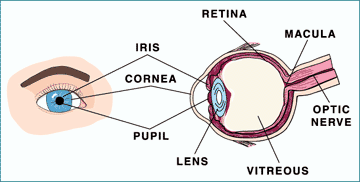How Vision Works

Parts of the Eye
Cornea
The clear dome which covers the iris and pupil of the eye. It is the 'window' of the eye. It transmits and focuses light into the eye.
Iris
The colored part of the eye. The iris helps regulate the amount of light that enters the eye.
Pupil
The dark center in the middle of the iris. The pupil determines how much light is let into the eye. It changes sizes to accommodate for the amount of light that is available.
Lens
The transparent structure inside the eye that focuses light rays onto the retina.
Retina
The lining in the back of the eye that is made up of light-sensitive tissue. The retina receives light impulses, converting them into nerve pulses which are sent via the optic nerve to the brain. The brain then interprets the impulses as images, allowing you to see.
Macula
A small area in the retina that contains special light-sensitive cells. The macula allows us to see fine details clearly.
Optic Nerve
The nerve that connects the eye to the brain. The optic nerve carries the impulses formed by the retina to the brain, which interprets them as images.
Vitreous
The clear, jelly-like substance that fills the middle of the eye.
How The Eye Works
Normally, as light enters the eye, it is refracted (bent) by the cornea, which then focuses the light onto the retina at the back of the eye. The shape of the eye and the curve of the cornea are what determine your level of visual acuity. It is the distortion or irregularities in these that cause refractive errors.
Nearsightedness
Also known as myopia, the light entering the eye doesn't focus on the retina, but at some point in front of it. It is frequently caused by an abnormally long eye shape, or by an excessive curvature of the cornea. When this occurs, objects at a distance appear blurry. Many of these patients start wearing correction in elementary school and progress until late teens/early twenties. Research shows that 25%-30% of people are myopic.
Farsightedness
Also known as hyperopia, the light entering the eye focuses at a point behind the retina, making objects that are held closer to the eye blurry, while those far away are in focus. It is frequently caused by an abnormally short shaped eye, or an excessively flat cornea. Many patients that are farisighted wear glasses when they are very young and then go through a period in life when they do not need correction. When they get into their 40s they start to need correction again for near and then eventually distance also.
Astigmatism
This is caused not by the length of the eye, but the shape. The normal cornea is shaped like a ball. An astigmatic eye, however, takes a football-like shape. The result is that objects are not focused into a single image. Vision is blurred and distorted.
Presbyopia
The inability to focus on objects close-up. The condition occurs when the lens of the eye loses its ability to focus at close range. It is a normal occurrence, usually beginning in the early forties, tending to decrease visual acuity with age.
Corrections
Nearsightedness, farsightedness and astigmatism (refractive errors) are typically corrected with glasses or contact lenses. Both of these forms of correction are expensive, not to mention just plain inconvenient — diminished peripheral vision, lenses fogging when you walk in from outdoors, having to change between glasses and expensive prescription sunglasses when walking in and out of doors, scratches and glare.
Then there is the more convenient option: contact lenses. Better vision than glasses? Sure. Worry free? No. For those who can wear them, contact lenses are a great temporary fix to poor visual acuity. Putting all the cleaning solutions, cases, saline drops, rips, tears, etc. aside, the fact still remains that when you take them out — you can't see.
Laser surgery gives you the gift of clear, stable vision quickly and painlessly. There are several surgical options and they can correct most refractive eye problems allowing for improvement in your eyesight. Click here to learn more about available surgical options.


